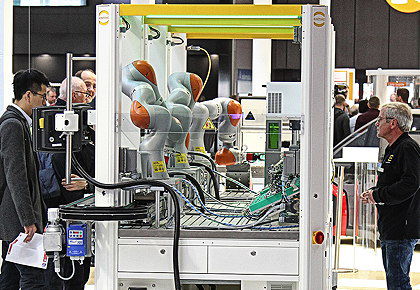- Home » News » World News
Group aims to standardise industrial cloud interfaces

More than 30 companies and organisations involved in industrial automation and communications have come together to draw up a standard interface for industrial cloud communications that will ensure interoperability between factory systems and cloud platforms.
The companies, trade bodies and research institutes behind the Industrial Cloud Federation initiative include Siemens, ABB Stotz, Harting, Robert Bosch, Phoenix Contact, Kuka, Microsoft, Schaeffler, Hitachi, Wittenstein, Cedalo, GE Intelligent Platforms, IBM and Fujitsu, as well as the German VDMA trade body and three Fraunhofer research institutes. Several of them demonstrated early results from the project at the 2019 Hannover Fair.
Component, sensor and actuator manufacturers, platform providers, as well as mechanical and plant engineers, are increasingly relying on cloud infrastructures and platforms for services such as condition monitoring and predictive maintenance. In Germany, for example, two thirds of companies are thought to be using cloud technologies already.
But cloud computing is not without its drawbacks and limitations, which range from the cost of implementing and operating cloud schemes, to worries about the security implications of sending data to remote servers. At a more basic level, there are questions over interoperability, differing specifications, and incompatible interfaces between different systems.
Providers of cloud-based systems and services are finding that the challenges of communication and data exchange are becoming increasingly complex. Due to the variety of cloud infrastructures and platforms, multi-cloud applications have to combine different proprietary application and transport protocols, as well as security standards. The lack of interoperability increases the effort and is holding back the implementation of new business models.
The Industrial Cloud Federation is therefore developing a prototype standard, called DIN SPEC 92222, which is intended to safeguard the interoperability and communications between IT systems and physical devices. The norm implements a reference model aimed at achieving universal, standardised communications from field devices through to multi-cloud applications, based on OPC UA.
DIN SPEC documents are designed to be used as the basis for developing full standards. They should not conflict with existing standards.
The new standard covers communications between machines (and, in particular, edge components, including sensors, actuators and control systems) and manufacturers’ cloud platforms, as well as with those operated by their suppliers. It sets out interoperability criteria such as transport protocols and will help to ensure reliable communications between different cloud systems and machines, irrespective of the manufacturer.
“The standard is aimed particularly at operators and manufacturers of machines and plants who offer and use cloud-based services and systems, as well as at providers of remote services,” explains Christoph Legat, a software professional at the Expleo Group, one of the leaders of the standardisation initiative.
The group believes that the standard will offer many potential advantages to the engineering sector, including well-defined rules governing conformity that will allow plant operators to retain control over their data and infrastructures. The use of uniform application and transport protocols should the reduce the amount of time and effort needed to maintain applications. And uniform standards will also mean that operators will not have to rely on any one cloud platform, as well as simplifying integration with other platforms.

Another potential attraction is the simplification of communications between the field level and the cloud, and access from the cloud to machines. The specification also supports new service models, such as pay-per-use.
Demonstrations of applications of DIN SPEC 92222 at the Hannover Fair included:
• A Cedalo Streamsheet server-based spreadsheet acting as an IoT edge gateway connected to a Festo CMMT servodrive controller and EGC electric linear axis. The Streamsheet was providing customisable dashboards for visualisation, analysis and condition monitoring.
• Fujitsu’s Intelliedge OEM cloud platform acting as the central hub for a demo involving a Kuka simulator and a Wittenstein “smart” gearbox.
• Harting’s Mica platform acting as a gateway to integrate and aggregate robot status data from its HAII4YOU smart factory, and integrating the data into Fujitsu’s OEM cloud.
• Wittenstein, which was showing how its cynapse integrated sensor module can be used to retrieve data such as temperature, vibrations and operating times from its gearboxes.





